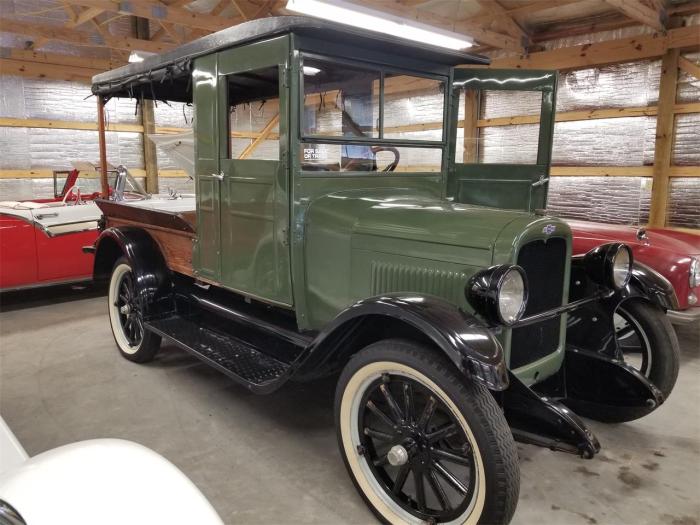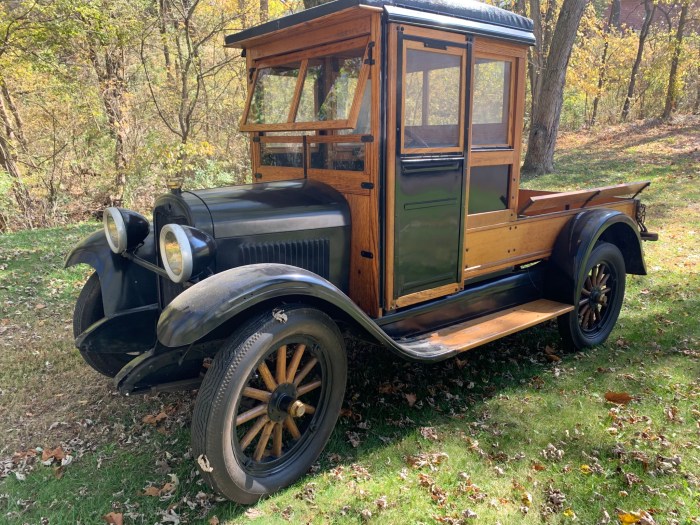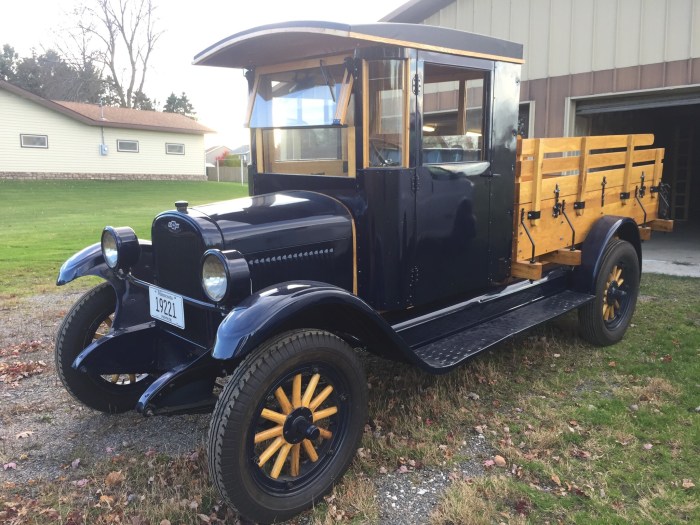The 1926 Chevrolet Pickup was a groundbreaking vehicle that helped shape the American automotive landscape. It arrived during a time of immense economic growth and social change, a period when the automobile was rapidly becoming a symbol of both progress and personal freedom.
Chevrolet, already a prominent player in the market, saw an opportunity to capitalize on this burgeoning demand for trucks, and the 1926 Pickup was their answer. This sturdy workhorse was designed to meet the needs of farmers, businesses, and individuals alike, and its success helped solidify Chevrolet’s reputation as a reliable and innovative automaker.
The 1926 Chevrolet Pickup stood out for its robust construction and practicality. Its design, while simple, was well-suited for the demands of the time. The truck was powered by a four-cylinder engine, providing adequate power for hauling goods and navigating rough roads.
It offered a range of features that made it a versatile and desirable choice for its intended audience.
Historical Context
The year 1926 marked a pivotal point in the American automotive industry, a period characterized by burgeoning growth, technological advancements, and a shift in consumer preferences. This era witnessed the rise of the automobile as a symbol of both progress and prosperity, shaping the social and economic landscape of the nation.
The American economy was experiencing a period of unprecedented prosperity, fueled by the roaring twenties, a time of widespread consumerism and industrial expansion. This economic boom, coupled with the emergence of mass production techniques, made automobiles more affordable and accessible to a wider segment of the population.
The social landscape was also undergoing significant transformations, with the automobile playing a central role in facilitating greater mobility, urbanization, and suburbanization.
Chevrolet’s Position in the Market
Chevrolet, under the leadership of Alfred P. Sloan, Jr., had established itself as a leading player in the American automotive market. The company’s focus on affordability and innovation, coupled with its effective marketing strategies, propelled it to become one of the most popular car brands in the nation.
Chevrolet’s success was evident in its consistent sales growth, which further solidified its position as a major force in the industry.
The 1926 Chevrolet Pickup, a workhorse of its time, represented a significant step in the evolution of the American automobile. While it may seem worlds away from the sleek and stylish 1956 Chevrolet Bel Air , both vehicles embody the spirit of innovation and practicality that Chevrolet has become known for.
The 1926 Pickup, with its sturdy design and reliable engine, was a cornerstone for businesses and individuals alike, setting the stage for the iconic trucks that Chevrolet would produce in the decades to come.
Chevrolet’s success was not merely a result of its marketing efforts but also a testament to its commitment to producing reliable and affordable vehicles. The company’s engineering prowess and innovative design practices enabled it to develop vehicles that were both durable and appealing to a wide range of consumers.
The Chevrolet pickup truck, introduced in 1925, quickly gained popularity for its versatility and practicality, becoming a popular choice for farmers, ranchers, and small businesses.
1926 Chevrolet Pickup Design and Features

The 1926 Chevrolet Pickup, a robust workhorse, reflected the burgeoning automotive industry of the era. Its design and features aimed to provide both practicality and affordability for the growing commercial and agricultural sectors.
Design Elements
The 1926 Chevrolet Pickup showcased a simple yet functional design. The vehicle featured a sturdy steel frame, a wood-plank bed, and a classic, boxy body. The body was painted in a single color, typically black, and featured a prominent Chevrolet emblem on the radiator grille.
The pickup had a long wheelbase, providing ample cargo space, and its high ground clearance ensured it could handle rough terrain.
Engine Specifications and Performance
The 1926 Chevrolet Pickup was powered by a 288 cubic inch, four-cylinder engine, generating around 20 horsepower. This engine was known for its durability and fuel efficiency. The engine was paired with a three-speed manual transmission, providing a straightforward driving experience.
The 1926 Chevrolet Pickup was a workhorse of its time, known for its rugged construction and reliability. While it lacked the sleek design and modern amenities of later models like the 1965 Chevrolet Nova II , it provided essential transportation for businesses and individuals alike.
The 1926 Chevrolet Pickup, with its distinct vintage charm, continues to capture the attention of collectors and enthusiasts today, serving as a reminder of Chevrolet’s enduring legacy in the automotive world.
While the pickup was not particularly fast, its robust engine and transmission allowed it to handle heavy loads and navigate challenging road conditions.
Unique Features and Options
The 1926 Chevrolet Pickup offered a range of features designed to enhance its utility. These included:
- A robust steel frame provided structural integrity and durability, making it suitable for carrying heavy loads.
- A wood-plank bed offered a versatile cargo area that could be easily adapted for various needs.
- A high ground clearance ensured that the pickup could handle uneven terrain and rough roads.
- A large radiator grille helped to dissipate heat effectively, preventing overheating.
- A prominent Chevrolet emblem on the radiator grille emphasized the vehicle’s brand identity.
- A three-speed manual transmission provided a simple and reliable driving experience.
The 1926 Chevrolet Pickup was a basic yet reliable vehicle, designed for practicality and affordability. Its design elements, engine specifications, and features made it a popular choice for farmers, businesses, and individuals who required a robust and versatile workhorse.
Production and Sales

The 1926 Chevrolet Pickup, like other vehicles from the era, was produced in significant numbers, reflecting the growing demand for trucks in the burgeoning American economy. Understanding its production volume and sales success is essential for appreciating its impact on the automotive landscape.
Production Volume
Chevrolet did not release specific production figures for the 1926 Pickup. However, it is estimated that the company produced thousands of these trucks during the year. This estimate is based on the overall production numbers for Chevrolet vehicles in 1926, which were substantial, and the increasing popularity of light trucks at the time.
Target Market and Intended Use
The 1926 Chevrolet Pickup was primarily targeted at businesses and individuals requiring a reliable and affordable workhorse for hauling goods and materials. Its intended uses were diverse and included:
- Delivery Services:Businesses relied on the pickup for transporting goods to customers, especially in urban areas where smaller trucks were more maneuverable.
- Farming:Farmers used the pickup for hauling crops, livestock, and supplies, making it an essential tool for agricultural operations.
- Construction:Construction companies employed the pickup for transporting materials and equipment to job sites, contributing to the rapid development of infrastructure in the 1920s.
- General Transportation:The pickup also served as a versatile vehicle for general transportation, particularly for individuals who needed a more robust and capable vehicle for hauling larger items.
Factors Contributing to Sales Success
The 1926 Chevrolet Pickup achieved significant sales success due to several key factors:
- Affordability:Chevrolet was known for producing vehicles at competitive prices, making the pickup accessible to a wide range of buyers, including small businesses and individuals.
- Reliability:Chevrolet’s reputation for building sturdy and dependable vehicles contributed to the pickup’s popularity. Its robust design and construction ensured it could handle the demands of various work environments.
- Versatility:The pickup’s versatility made it suitable for a wide range of applications, further enhancing its appeal to a diverse customer base.
- Growing Demand:The booming economy of the 1920s fueled a surge in demand for trucks as businesses and individuals sought efficient transportation solutions for their needs.
Impact and Legacy

The 1926 Chevrolet Pickup, despite its relatively simple design, played a pivotal role in shaping the future of the truck industry. It helped solidify Chevrolet’s position as a leading manufacturer of commercial vehicles and paved the way for the widespread adoption of trucks in American society.
Impact on Truck Design and Development
The 1926 Chevrolet Pickup’s influence on truck design and development is evident in its innovative features and its contribution to the evolution of the truck market.
- Mass Production:The 1926 Chevrolet Pickup was one of the first trucks to be mass-produced, making it more affordable and accessible to a wider range of consumers. This significantly contributed to the growth of the truck market and its widespread adoption for various purposes.
- Durability and Reliability:The 1926 Chevrolet Pickup was known for its durability and reliability, qualities that were crucial for its intended use in demanding work environments. This reputation for robustness further contributed to its popularity and influenced the development of future trucks.
- Versatility:The 1926 Chevrolet Pickup’s versatility, with its ability to be adapted for various tasks, contributed to its widespread appeal. Its adaptability inspired the development of specialized trucks for specific industries and applications.
The 1926 Chevrolet Pickup’s Enduring Legacy
The 1926 Chevrolet Pickup’s impact extends beyond its initial production run. Its legacy continues to inspire and influence truck design and development even today.
- Influence on Modern Truck Design:The 1926 Chevrolet Pickup’s simple, functional design laid the groundwork for modern truck design. Its emphasis on practicality and durability continues to be reflected in the trucks of today.
- Symbol of American Work Ethic:The 1926 Chevrolet Pickup became a symbol of the American work ethic, representing hard work, reliability, and resilience. This association with hard work and practicality has contributed to the enduring appeal of trucks in American culture.
- Cultural Significance:The 1926 Chevrolet Pickup played a significant role in American culture, becoming a part of everyday life for many Americans. Its influence can be seen in popular culture, literature, and even in the way we view the role of trucks in society.
Contemporary Reviews and Comparisons

The 1926 Chevrolet Pickup, while a significant step forward for the company, faced a competitive landscape with established players like Ford and Dodge. Reviews of the time highlight its strengths and weaknesses, offering insights into its place in the market.
Contemporary Reviews
Contemporary reviews of the 1926 Chevrolet Pickup generally praised its affordability, reliability, and versatility. Automotive publications like
- The Automobile* and
- Motor Age* highlighted its robust construction, sturdy engine, and ease of maintenance. The pickup was often lauded for its ability to handle a variety of tasks, from hauling goods to transporting passengers. However, some reviewers criticized its lack of power, particularly when loaded, and its relatively basic features compared to more expensive competitors.
Comparison with Competitors
The 1926 Chevrolet Pickup was positioned against competitors like the Ford Model T Pickup and the Dodge Brothers Pickup. While the Ford Model T Pickup was known for its simplicity and affordability, it was considered less powerful and less comfortable than the Chevrolet.
The 1926 Chevrolet Pickup was a workhorse, designed for utility and durability. It represented a significant shift in automotive design, moving from the era of Model T simplicity to a more robust and versatile vehicle. This shift in Chevrolet’s approach is mirrored in their later creations, like the iconic 1968 Chevrolet Corvette Stingray , a vehicle that prioritized performance and style.
While the 1926 Pickup was a symbol of hard work, the Stingray represented a different kind of American dream, one fueled by speed and luxury. Despite their differences, both vehicles reflect the enduring legacy of Chevrolet, a brand that has consistently adapted to the changing needs of its customers.
The Dodge Brothers Pickup offered more power and features but came at a higher price. The Chevrolet Pickup, with its balance of affordability, reliability, and versatility, aimed to appeal to a wide range of buyers, particularly those seeking a practical and cost-effective workhorse.
Strengths and Weaknesses
The 1926 Chevrolet Pickup’s strengths included:
- Affordability:The Chevrolet Pickup was priced competitively, making it accessible to a wider range of buyers.
- Reliability:The robust construction and simple design of the Chevrolet Pickup contributed to its reputation for reliability.
- Versatility:The pickup’s ability to handle various tasks, from hauling goods to transporting passengers, made it a versatile choice for businesses and individuals.
However, it also had some weaknesses:
- Limited Power:The Chevrolet Pickup’s engine, while reliable, lacked the power of some competitors, particularly when loaded.
- Basic Features:Compared to more expensive competitors, the Chevrolet Pickup offered a relatively basic level of features and comfort.
Illustrative Examples: 1926 Chevrolet Pickup
The 1926 Chevrolet Pickup, a pioneering vehicle in the burgeoning commercial truck market, played a significant role in shaping the landscape of transportation. To better understand its place in history, we’ll examine its design and features compared to contemporary trucks and delve into a fictional account of a 1926 Chevrolet Pickup owner.
Comparison with Contemporary Trucks, 1926 Chevrolet Pickup
To fully grasp the significance of the 1926 Chevrolet Pickup, it’s essential to compare it with other trucks available at the time. Here’s a table highlighting key features of the 1926 Chevrolet Pickup alongside its competitors:
| Feature | 1926 Chevrolet Pickup | Ford Model TT | Dodge Brothers D-1 |
|---|---|---|---|
| Engine | 194 cubic inch, 4-cylinder, 20 hp | 201 cubic inch, 4-cylinder, 20 hp | 201 cubic inch, 4-cylinder, 22 hp |
| Transmission | 3-speed manual | 3-speed manual | 3-speed manual |
| Payload Capacity | 1 ton | 1 ton | 1 ton |
| Wheelbase | 112 inches | 112 inches | 112 inches |
| Price | $495 | $440 | $595 |
Visual Representation
The 1926 Chevrolet Pickup was a robust, utilitarian vehicle with a simple yet functional design. Imagine a truck with a boxy cab and a long, flatbed cargo area. The front grille featured a horizontal, chrome-plated bar with the Chevrolet emblem prominently displayed in the center.
The headlights were round and mounted on the front fenders. The truck’s body was constructed of wood and steel, and it was available in a variety of colors.
Fictional Account
“My 1926 Chevrolet Pickup was my pride and joy. I used it to haul everything from lumber and supplies to produce from my farm. It was a workhorse, always ready to get the job done. I remember one time, I had to deliver a load of hay to a neighbor’s farm. The roads were muddy, and it was a long drive, but my Chevrolet never faltered. It took me there and back, and I knew I could always count on it.”John Smith, 1926 Chevrolet Pickup Owner
Last Point

The 1926 Chevrolet Pickup remains a significant milestone in automotive history. Its impact can be seen in the evolution of truck design and the continued popularity of Chevrolet’s pickup truck line. The legacy of this classic vehicle lives on, not only in the memories of those who owned and used it, but also in the enduring influence it has had on the industry.
The 1926 Chevrolet Pickup is a testament to the ingenuity and resourcefulness of the era, a reminder of the enduring power of a well-designed and well-built truck.